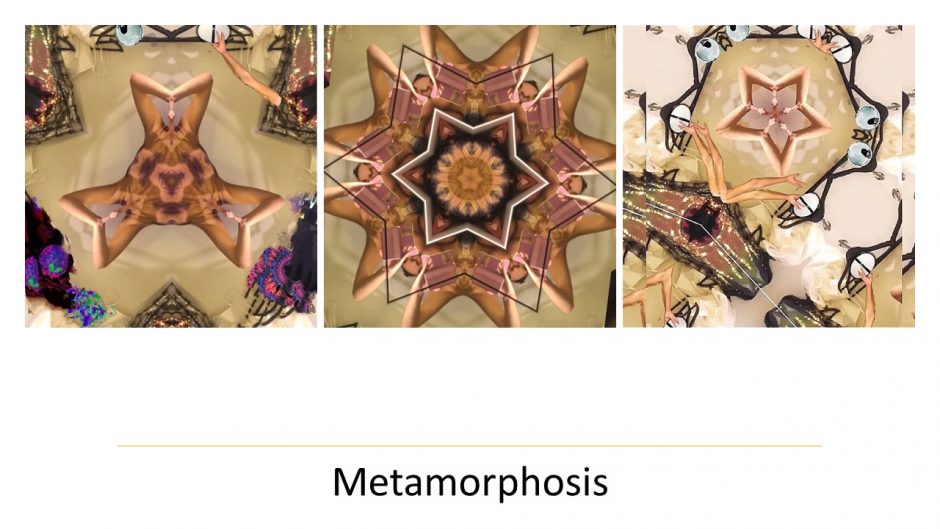
Fictional Café is pleased to showcase the creative work of up-and-coming Shanghai artist Qinrui Chen. We believe her education in neuroscience adds a quite a unique perspective to her art.
Artist’s Statement – “We can’t talk about surrealism without mentioning realism as a reference, like Godzilla and sci-fi – its distinct character is its ‘size of a building’ and fixation on the deconstruction of ‘office space.’ What makes it surreal but still manages to be meaningful is it brings us to reflect on questions of realism: how do we deal with the inner monster, how to seek the individual dream of a powerful superego in a suppressive social-political environment per Godzilla, or strangely per A Hundred Years of Solitude too (to some extent).

“So I find the most realism I can: the medical image of cell structures, C4D re-construction of proteins, photography of everyday objects, and these I rearrange in a way that’s super-saturated and . . . uncomfortable. Heart muscle cells for a Valentine’s card, superhuman in a petri dish, etc. Naturally, my education in neuroscience helps me with the early stages of material-gathering and a perspective for reading into surrealism with a fresh eye. That’s when BioArt comes into play.

“Interestingly, BioArt is not yet a genre but more a technique. There’s experimental body modification in ‘Third Hand’ and ‘Ear on Arm’ by Stelarc, or ‘Que le cheval vive en moi’ (May the horse live in me) by Art Orienté Objet, injecting horse immunoglobulins into artist’s blood circulation or simple bio-hacking visuals of making bacteria culture in the shape of your face. They don’t seem to have a similar message; some are for demystifying, some for mocking technology’s control, etc., and it is sometimes political, as in the need for collaborations of artists with labs and their requirement to pass strict screening. For me, I’ve yet to start labs but I am content with photography for now.

“That being said, with some pioneers going through DNA modification, or body enhancement, sometimes challenging the very ethical boundaries of art censorship, such as Marco Evaristti’s piece ‘Helena & El Pescador.’ It is goldfish in a blender and audiences are invited to switch on the blender, thus killing the fish. I’d like to clarify/defend my way, at least the way I interpret my work. It is not aesthetics through uncomfortableness, but it as a forward-thinking example to raise questions about the very nature of the value of life through more fundamental and long-lasting media. Not everyone has to go through that to be a thinker; the important takeaway for me is more so artists or influencers will take the time to add rationales to their once one-sided aesthetic appreciation.

“Under the Chinese one-child policy back in 90s, I was the second child born by chance because the first child, my brother, was stillborn. Ever since, I have learned that I see magical ‘after-effects’ in daily life when it comes to philosophical questions of existence, both the beauty and the vile in it: human body parts in their prime, or medical images showing how cells get consumed under an attack by a foreign entity. What I do is just making this visible to other viewers, to share the wonder of what I see in the world. I usually take photos and reconstruct them with Photoshop and other apps (such as 2D and video projection) that give glitch effects, to push the aesthetic of a human figure to an extreme with ultra-bright color and misconfigurations of people and objects. It’s weird and sometimes uncomfortable, yet it doesn’t cease to be beautiful.
“That’s my statement, and I hope the viewers can come back from it having more appreciation of their own beauty within. Compared to the development of BioArt, I seek to challenge the existential question of ‘one has to imagine Sisyphus happy’ (finding joy in pointless repetition). To the most microscopic perspective, everything indeed follows the rules of physics and predictability, once proper algorithms and parameters in decision-making models are applied. But when they aggregate – nucleus, cells, organs, people – things happen, wonderful things happen. In the future I hope to do more projects in transhumanism, the evolutionary shift to combining the human with technology. “

Qinrui Chen is a young professional in biotech who graduated in 2017 from New York University, Shanghai, in Neuroscience with a minor in business studies. She has an interest in graphic design. Her work is focusing on BioArt and surrealism, juxtaposing over-saturated daily mundanity and medical images of human bodies, to raise questions and therefore to re-think the biological existence of humanity in urban development.
Publications and exhibitions – 2019
Adornment of my crown (exhibition with The Primary Movement). Georgia, US
Gatekeeper magazine issue03, featured artist. Shanghai, China, Gatekeeper magazine exhibition: Monoculture. @TMP Shanghai, China. A5 magazine, featured artist (June issue ); Doubletake (online blog). Polemical magazine Issue 08, visual artist. Icecubes Zine Issue 06, featured contributor. Average Art Magazine, featured artist [June Issue)
Wotisart, featured artist (June Issue).
Pidgeonholes Literature Review (online)
Seagery Zine 03 Other side of Paradise
F*EMS zine Issue 14 Flowers. Email: chenqinrui888@126.com
Instagram @chenqinrui888
Linkedin Qinrui Chen


It might be good, but the work is too small to view. Whatever your format, I couldn’t double click to enlarge the photos.
Hello! Thank you for bringing that to our attention. We’ll look into it and see if we can change how it displays. But in the meantime, you’ll be able to see more of Qinrui Chen’s art at her Instagram account https://www.instagram.com/chenqinrui888/